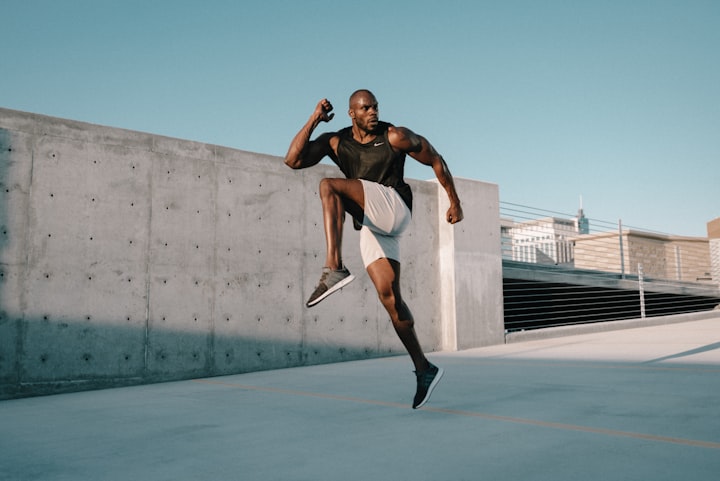The Key to Building Muscle and Losing Fat at the Same Time
How incorporating sprinting into your workout will lead to incredible muscle gain and fat loss.

Just one year ago, I was lean, muscular, and strong. My body fat percentage was about 10%, and I looked really healthy. Recently, I haven’t been satisfied with my appearance nor my performance in the gym. As far as I could tell, nothing had changed in the past year. Until I realized: sprints! I wasn’t sprinting anywhere near as much as I used to.
Look at any short distance runner and you will see what I mean. They’ve got big legs, six-pack abs, and even big, chiseled arms. They’re built. Look at Usain Bolt — lean, muscular, and powerful.
Some of the most muscular people I know are really quick. And that’s the secret: training for speed encourages both muscle growth and fat loss, leading to improved body composition.
Here are the benefits of sprinting, and how you can include this into your exercise regime.
Muscle gain
“Sprinting is arguably the best exercise for building the hamstrings, glutes, calves, and quads.” — Javier Garza, author for Breaking Muscle
Sprinting speeds up the process of hypertrophy (muscle growth).
Your muscles have slow twitch fibres and fast twitch fibres. Slow twitch fibres are your endurance fibres — they are resistant to fatigue and can therefore work for long periods of time, but they aren’t very powerful. Fast twitch fibres on the other hand are powerful and lead to quick movements, but they fatigue quickly. Our muscles contain both types of fibres, but the ratio for each person will be different. A marathon runner, for example, will have a lot of slow twitch fibres, whereas a sprinter will have lots of fast twitch fibres.
Typically, non-athletes have an equal proportion of each. However, our ratios change depending on how we train. Long distance runners will develop more slow twitch fibres and sprinters will develop more fast twitch fibres.
Fast-twitch fibres are better able to increase their size than slow-twitch fibres, and therefore sprinting can lead to increased muscle growth. The higher proportion of fast twitch fibres you have, the easier it will be for your muscles to grow.
A study was conducted on men and women between the ages of 20–30, where the participants had to complete an anaerobic test on a stationary bike. The researchers found that this exercise upregulated the Akt/mTOR pathway, and the effect was greater in the women than the men. This pathway is important for muscle growth and preventing muscle atrophy (loss).
Sprinting produces forces on your body equal to three times your bodyweight. While not using any extra weights, sprinting actually acts as a form of resistance training, due to this force on the body. This leads to increased hypertrophy.
Protein synthesis
Sprinting promotes protein synthesis by enhancing the protein synthesis pathways by up to 230%. Therefore, after a sprint session your body will ramp up its protein synthesis — the process where your body makes protein to repair damaged cells — i.e. the muscle growing part of exercise.
This study showed that sprinting increased protein synthesis, but only when sprinting in a non-fasted state. Therefore, if you’re using sprinting for muscle building, it is recommended that you eat first.
Abdominal activation
The primary role of the core is to prevent movement — extension, rotation, and flexion. When you are sprinting, your core is preventing all of these movements from occurring — keeping your trunk stable and without movement.
Therefore, while you are sprinting your core will be tightly engaged.
“Notice the abs of Olympic sprinters. Rarely are ab workouts the top priority of world-class sprinters and that is because their cores are built on the track.” — Katie Chasey, founder and head trainer for the RXBound training team
But be sure to ensure that your core is engaged when you are sprinting and that your lower back isn’t arching. This will only cause pain and possibly injury, and will do nothing to improve your abs. Run slower until you can achieve this.
CNS potentiation
Sprinting prepares your body for work — either a sports game, lifting session, or a race. This is why you see athletes running short sprints before a big game, or before a race. Your central nervous system (CNS) warms up and engages. In regard to muscle growth, this has the effect of allowing you to produce more force (and therefore lift more) during your session, leading to bigger gains.
“By sequencing some speed work immediately after your warm-up or movement prep but before strength work, your CNS and force output will be far greater, resulting in more growth.” — Travis Hansen, writer for T Nation
Human growth hormone production
Sprinting leads to a huge hormonal response in the body, and especially increases human growth hormone (HGH) production when compared to endurance training, and is an important hormone for promoting tissue growth in the body. It promotes muscle tissue repair (again, the muscle building aspect of exercise), increases protein production, and enhances the mobilization of fatty acids.
Fat loss
High intensity interval training (HIIT) has long been associated with fat loss. However, a recent meta analysis has found that sprint interval training leads to almost 40% more fat loss than HIIT training, despite exercising for 60% less time. Compared to continuous cardio exercise, sprinting led to 91.8% more fat loss and 71.1% less time exercising. You can see why sprints are so powerful — big results from little time commitment.
The main mechanism behind this fat loss is the huge metabolic response to sprinting:
- Increased post exercise oxygen consumption (EPOC) which leaves you burning a lot of calories for hours after completing your workout
- Increased insulin sensitivity
- Increased testosterone production
- Increased proportion of fast-twitch muscles, which burn more calories at rest than slow-twitch muscles.
- Increased fat burning both during and after your workout.
“Body fat stores rapidly decrease and muscle size increases once sprinting is employed. One reason is the effect (and after-effect) sprinting has on our underlying physiology. Sprinting significantly increases EPOC, or post-exercise oxygen consumption, which sucks up calories like a sponge for hours after high intensity training.” — Travis Hansen
Implementation
Warm up
Do a comprehensive warm up first — 5 minutes of moderate movement (jog, bike, row, etc.), followed by dynamic movements (such as hamstring sweeps, world’s greatest stretch, and slow lunges).
Sprint
Option 1: 6–10 100m max efforts
Option 2: 6–10 max effort hill sprints (find a hill that takes you about 10 seconds to run up)
Option 3: 4–8 30s max efforts (this is the protocol of the meta analysis mentioned above)
Rest
Between sprints: Take a 2–4 minute rest between each sprint — it’s about being explosive, not increasing fitness. Rest completely before starting again, and stop your session if your muscles are fatiguing or your form is deteriorating.
Between sessions: Only sprint on rested legs — again, it’s not about building endurance. You want to be as explosive as possible each time you sprint. Don’t sprint on consecutive days and don’t sprint after doing a weights session. The sprint should be your main focus for the day. Aim for 1–3 sessions a week.
To conclude
Sprinting is an incredible tool for both muscle gain and fat loss. It’s quick and simple to implement but has so many benefits, such as:
At only 2–4 minutes of work, one or two times a week, there really is no reason not to give sprinting a try. You will soon see why it’s such a powerful tool.
About the Creator
Ashley Richmond
My mission is to make health simple. I write about daily practices and routines to optimize health. Small changes can have a big impact, and I want to help others take advantage of this.
Free newsletter: https://momentumhabits.substack.com/






Comments
There are no comments for this story
Be the first to respond and start the conversation.